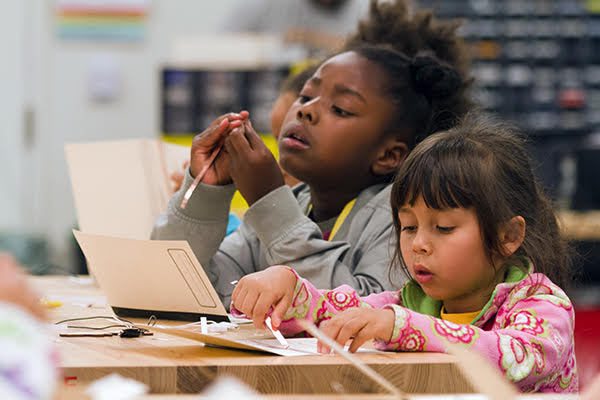Photo credit: Adriel Olmos, Scientific Adventures for Girls
According to Bay Area rocket scientist, toy maker, industrial designer, and educator Anne Mayoral, “Building confidence and having a positive experience when trying new things is essential in promoting a love of learning and intellectual exploration.” Anne, who first used Lectrokits (21st century notebooks) while teaching at the after-school and summer camp program Scientific Adventures for Girls found the activity templates to “..hit the sweet spot of learning. They take the out the mystery but keep the magic of building a circuit.”
At the center of all of Anne’s work is a desire to help people connect with their own curiosity and reasoning around science and technology. As both a designer and educator, she aims to facilitate the kind of thinking that pioneering inventors do, which she describes as “moving away from the blind trust one gets from reading the answers in a book and finding your own.” In her work with the toy company Wild Planet this translates into making accessible robotics kits. As an industrial designer, she used this idea to custom build a STEM oriented Rube Golderberg-esque miniature golf course for the restaurant Urban Putt. And in education, this means introducing accessible and mind-blowingly fun STEM projects at programs like Scientific Adventures for Girls.
Running just a little over two years, Scientific Adventures for Girls was launched to attract elementary school girls to STEM thinking through accessible hands-on interactive projects. Working out of the Oakland hackerspace “Curiosity Hacked,” the program piloted with fourteen Pearl Elementary School girls who met weekly to get a taste of the fun side of STEM. With projects such as marble runs, dancing Oobleck, Archimededian Screws, and paper circuits Anne focuses on getting the girls “into all things STEM, without getting bogged down in book learning or memorization.”
Photo credit: Adriel Olmos, Scientific Adventures for Girls
Before working with 21c Notebooking, Anne had done a paper circuits greeting card project but had found that it was a bit more difficult to execute than she had imagined. “There are some skills that need to be built into the lesson before you can execute a circuit correctly.” Aiming to design a learning experience that her students would succeed at, Anne started using some of the resource templates created by CV2 and NEXMAP – simple parallel circuit with a low profile 3V battery with tabs and a set of clip leads. “There’s really a sweet spot to helping somebody learn the process but still feel like they’re doing something cool. When I saw template I thought, this is going to be great.”




